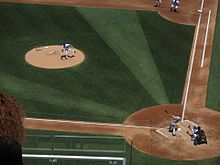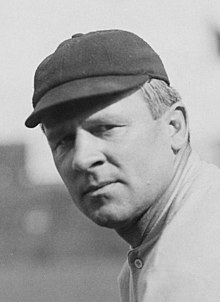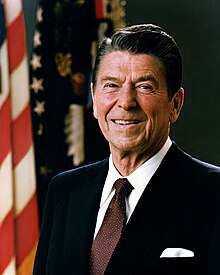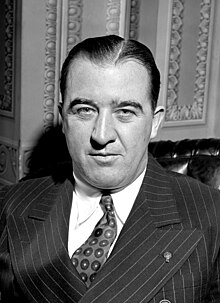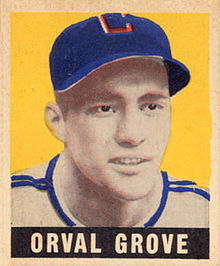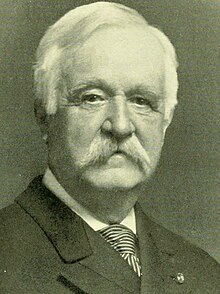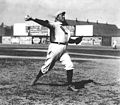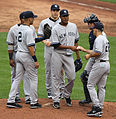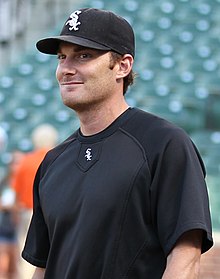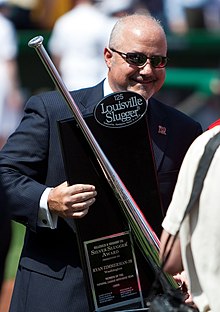Portal:Baseball
Portal maintenance status: (June 2018)
|
| Main page | Content, Categories & Topics | WikiProjects & Things you can do |
The Baseball Portal
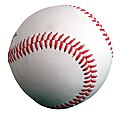
Baseball is a bat-and-ball sport played between two teams of nine players each, taking turns batting and fielding. The game occurs over the course of several plays, with each play generally beginning when a player on the fielding team, called the pitcher, throws a ball that a player on the batting team, called the batter, tries to hit with a bat. The objective of the offensive team (batting team) is to hit the ball into the field of play, away from the other team's players, allowing its players to run the bases, having them advance counter-clockwise around four bases to score what are called "runs". The objective of the defensive team (referred to as the fielding team) is to prevent batters from becoming runners, and to prevent runners advancing around the bases. A run is scored when a runner legally advances around the bases in order and touches home plate (the place where the player started as a batter).
The opposing teams switch back and forth between batting and fielding; the batting team's turn to bat is over once the fielding team records three outs. One turn batting for each team constitutes an inning. A game is usually composed of nine innings, and the team with the greater number of runs at the end of the game wins. Most games end after the ninth inning, but if scores are tied at that point, extra innings are usually played. Baseball has no game clock, though some competitions feature pace-of-play regulations such as the pitch clock to shorten game time.
Baseball evolved from older bat-and-ball games already being played in England by the mid-18th century. This game was brought by immigrants to North America, where the modern version developed. Baseball's American origins, as well as its reputation as a source of escapism during troubled points in American history such as the American Civil War and the Great Depression, have led the sport to receive the moniker of "America's Pastime"; since the late 19th century, it has been unofficially recognized as the national sport of the United States, though in modern times is considered less popular than other sports, such as American football. In addition to North America, baseball spread throughout the rest of the Americas and the Asia–Pacific in the 19th and 20th centuries, and is now considered the most popular sport in parts of Central and South America, the Caribbean, and East Asia, particularly in Japan, South Korea, and Taiwan. (Full article...)
 Featured articles - load new batch
Featured articles - load new batch
-
Image 1Rogers Hornsby tags out Babe Ruth who is caught attempting to steal second base, ending the 1926 World Series.
The 1926 World Series was the championship series of the 1926 Major League Baseball season. The 23rd edition of the Series, it pitted the National League champion St. Louis Cardinals against the American League champion New York Yankees. The Cardinals defeated the Yankees four games to three in the best-of-seven series, which took place from October 2 to 10, 1926, at Yankee Stadium and Sportsman's Park.
This was the first World Series appearance (and first National League pennant win) for the Cardinals, and would be the first of 11 World Series championships in Cardinals history. The Yankees were playing in their fourth World Series in six years after winning their first American League pennant in 1921 and their first world championship in 1923. They would play in another 36 World Series (and win 26 of those), as of the end of the 2023 season. (Full article...) -
Image 2Los Angeles Angels center fielder Mike Trout hits a home run on a pitch from New York Mets pitcher Tommy Milone on May 21, 2017.
Baseball is a bat-and-ball sport played between two teams of nine players each, taking turns batting and fielding. The game occurs over the course of several plays, with each play generally beginning when a player on the fielding team, called the pitcher, throws a ball that a player on the batting team, called the batter, tries to hit with a bat. The objective of the offensive team (batting team) is to hit the ball into the field of play, away from the other team's players, allowing its players to run the bases, having them advance counter-clockwise around four bases to score what are called "runs". The objective of the defensive team (referred to as the fielding team) is to prevent batters from becoming runners, and to prevent runners advancing around the bases. A run is scored when a runner legally advances around the bases in order and touches home plate (the place where the player started as a batter).
The initial objective of the batting team is to have a player reach first base safely; this generally occurs either when the batter hits the ball and reaches first base before an opponent retrieves the ball and touches the base, or when the pitcher persists in throwing the ball out of the batter's reach. Players on the batting team who reach first base without being called "out" can attempt to advance to subsequent bases as a runner, either immediately or during teammates' turns batting. The fielding team tries to prevent runs by using the ball to get batters or runners "out", which forces them out of the field of play. The pitcher can get the batter out by throwing three pitches which result in strikes, while fielders can get the batter out by catching a batted ball before it touches the ground, and can get a runner out by tagging them with the ball while the runner is not touching a base. (Full article...) -
Image 3
A picture of a Wii Sports disc
Wii Sports is a 2006 sports simulation video game developed and published by Nintendo for the Wii video game console. The game was released in North America along with the Wii on November 19, 2006, and in Japan, Australia, and Europe the following month. It was included as a pack-in game with the console in all territories except Japan, making it the first sports game included with the launch of a Nintendo system since Mario's Tennis for the Virtual Boy in 1995. The game was later released on its own as part of the Nintendo Selects collection of games.
Wii Sports is a collection of five sports simulations designed to demonstrate the motion-sensing capabilities of the Wii Remote. The five sports included are tennis, baseball, bowling, golf, and boxing. Players use the Wii Remote to mimic actions performed in real-life sports, such as swinging a tennis racket or rolling a bowling ball. The rules for each game are simplified to make them more accessible to new players. The game also features training and fitness modes that monitor players' progress in the sports. (Full article...) -
Image 4
John Joseph McGraw (April 7, 1873 – February 25, 1934) was an American Major League Baseball (MLB) player and manager who was for almost thirty years manager of the New York Giants. He was also the third baseman of the pennant-winning 1890s Baltimore Orioles teams, noted for their innovative, aggressive play.
McGraw was born into poverty in Truxton, New York. He found an escape from his hometown and a bad family situation through baseball, beginning a quick rise through the minor leagues that led him to the Orioles at the age of 18. Under the tutelage of manager Ned Hanlon, the Orioles of the 1890s won three National League (NL) pennants; McGraw was one of the stalwarts of the team alongside Wee Willie Keeler, Hughie Jennings, and Wilbert Robinson. The Orioles perfected the hit and run play and popularized the Baltimore chop; they also sought to win by intimidating the opposing team and the umpire. (Full article...) -
Image 5
Ronald Wilson Reagan (February 6, 1911 – June 5, 2004) was an American politician and actor who served as the 40th president of the United States from 1981 to 1989. He was a member of the Republican Party and became an important figure in the American conservative movement. His presidency is known as the Reagan era.
Born in Illinois, Reagan graduated from Eureka College in 1932 and was hired the next year as a sports broadcaster in Iowa. In 1937, he moved to California where he became a well-known film actor. During his acting career, Reagan was president of the Screen Actors Guild twice, from 1947 to 1952 and from 1959 to 1960. In the 1950s, he hosted General Electric Theater and worked as a motivational speaker for General Electric. Reagan's "A Time for Choosing" speech during the 1964 presidential election launched his rise as a leading conservative figure. After being elected governor of California in 1966, he raised state taxes, turned the state budget deficit into a surplus and implemented harsh crackdowns on university protests. Following his loss to Gerald Ford in the 1976 Republican Party presidential primaries, Reagan won the Republican Party's nomination and then a landslide victory over President Jimmy Carter in the 1980 presidential election. (Full article...) -
Image 6
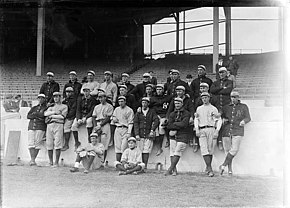
The 1913 squad, the first that went by the name "Yankees"
The history of the New York Yankees Major League Baseball (MLB) team spans more than a century. Frank J. Farrell and William Stephen Devery bought the rights to an American League (AL) club in New York City after the 1902 season. The team, which became known as the Yankees in 1913, rarely contended for the AL championship before the acquisition of outfielder Babe Ruth after the 1919 season. With Ruth in the lineup, the Yankees won their first AL title in 1921, followed by their first World Series championship in 1923. Ruth and first baseman Lou Gehrig were part of the team's Murderers' Row lineup, which led the Yankees to a then-AL record 110 wins and a Series championship in 1927 under Miller Huggins. They repeated as World Series winners in 1928, and their next title came under manager Joe McCarthy in 1932.
The Yankees won the World Series every year from 1936 to 1939 with a team that featured Gehrig and outfielder Joe DiMaggio, who recorded a record hitting streak during New York's 1941 championship season. New York set a major league record by winning five consecutive championships from 1949 to 1953, and appeared in the World Series nine times from 1955 to 1964. Mickey Mantle, Yogi Berra, and Whitey Ford were among the players fielded by the Yankees during the era. After the 1964 season, a lack of effective replacements for aging players caused the franchise to decline on the field, and the team became a money-loser for owners CBS while playing in an aging stadium. (Full article...) -
Image 7
Albert Benjamin "Happy" Chandler Sr. (July 14, 1898 – June 15, 1991) was an American politician from Kentucky. He represented Kentucky in the U.S. Senate and served as its 44th and 49th governor. Aside from his political positions, he also served as the second commissioner of baseball from 1945 to 1951 and was inducted into the Baseball Hall of Fame in 1982. His grandson, Ben Chandler, later served as congressman for Kentucky's Sixth District.
A multi-sport athlete during his college days at Transylvania College, Chandler briefly considered a career in professional baseball before deciding to pursue a law degree. After graduation, he entered politics and was elected as a Democrat to the Kentucky Senate in 1929. Two years later, he was elected lieutenant governor, serving under Governor Ruby Laffoon. Chandler and Laffoon disagreed on the issue of instituting a state sales tax and when Chandler, the presiding officer in the state senate, worked to block the legislation, Laffoon's allies in the General Assembly stripped him of many of his statutory powers. The tax then passed by a narrow margin. Knowing that Laffoon would try to select his own successor at the Democratic nominating convention, Chandler waited until Laffoon left the state—leaving Chandler as acting governor—and called the legislature into session to enact a mandatory primary election bill. The bill passed, and in the ensuing primary, Chandler defeated Laffoon's choice, Thomas Rhea. He then went on to defeat Republican King Swope by the largest margin of victory for a Kentucky gubernatorial race at that time. As governor, Chandler oversaw the repeal of the sales tax, replacing the lost revenue with new excise taxes and the state's first income tax. He also enacted a major reorganization of state government, realizing significant savings for the state. He used these savings to pay off the state debt and improve the state's education and transportation systems. (Full article...) -
Image 8
Harmon Clayton Killebrew Jr. (/ˈkɪlɪbruː/; June 29, 1936 – May 17, 2011), nicknamed "the Killer" and "Hammerin' Harmon", was an American professional baseball first baseman, third baseman, and left fielder. He spent most of his 22-year career in Major League Baseball (MLB) with the Minnesota Twins. A prolific power hitter, Killebrew had the fifth-most home runs in major league history at the time of his retirement. He was second only to Babe Ruth in American League (AL) home runs, and was the AL career leader in home runs by a right-handed batter. Killebrew was inducted into the National Baseball Hall of Fame in 1984.
Killebrew was 5-foot-11-inch (180 cm) tall and 213 pounds (97 kg). His compact swing generated tremendous power and made him one of the most feared power hitters of the 1960s, when he hit at least 40 home runs per season eight times. In total Killebrew led the league six times in home runs and three times in RBIs, and was named to 13 All-Star teams. In 1965, he played in the World Series with the Twins, who lost to the Los Angeles Dodgers. His finest season was 1969, when he hit 49 home runs, recorded 140 RBIs and won the AL Most Valuable Player Award while helping lead the Twins to the AL West pennant. (Full article...) -
Image 9
Orval Leroy Grove (August 29, 1919 – April 20, 1992) was an American professional baseball pitcher in Major League Baseball who played for ten seasons in the American League with the Chicago White Sox. In 207 career games, Grove pitched 1,176 innings and posted a win–loss record of 63–73, with 66 complete games, 11 shutouts, and a 3.78 earned run average (ERA).
The only freshman on the Proviso Township High School varsity baseball team, Grove's pitching ability attracted the attention of the White Sox. After signing with the team in 1937, Grove moved between the major leagues and minor leagues for a few seasons until 1943, when he found a solid place in the White Sox's pitching rotation. Grove had a career-year in 1943, finishing the season with career-bests in ERA, wins, and complete games; in 1944, he made his only All-Star appearance. (Full article...) -
Image 10
Morgan Gardner Bulkeley (December 26, 1837 – November 6, 1922) was an American politician of the Republican Party, businessman, and insurance executive. In 1876, he served as the first president of baseball's National League and, because of that, was inducted into the National Baseball Hall of Fame in 1937, a choice that remains controversial, since his time as a baseball executive was short.
Bulkeley was born in East Haddam, Connecticut. His father was Judge Eliphalet Adams Bulkeley, a prominent local lawyer and businessman, who became the first president of the Aetna Life Insurance Company. The family moved to Hartford, where Morgan Bulkeley was educated, before he took a job in the city of Brooklyn, New York. He served briefly in the American Civil War, where he saw no combat. When his father died in 1872, he moved back to Hartford and became a bank president and a board member of Aetna, becoming its president in 1879, a post he held the rest of his life. (Full article...) -
Image 11
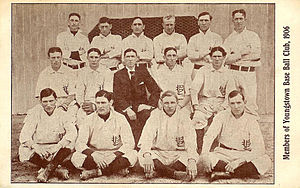
Youngstown Ohio Works (1906), with pitcher Roy Castleton seated in second row, second from left
The Youngstown Ohio Works baseball team was a minor league club that was known for winning the premier championship of the Ohio–Pennsylvania League in 1905, and for launching the professional career of pitcher Roy Castleton a year later. A training ground for several players and officials who later established careers in Major League Baseball, the team proved a formidable regional competitor and also won the 1906 league championship.
During its brief span of activity, the Ohio Works team faced challenges that reflected common difficulties within the Ohio–Pennsylvania League, including weak financial support for teams. Following a dispute over funding, the team's owners sold the club to outside investors, just a few months before the opening of the 1907 season. (Full article...) -
Image 12
Robert William Meusel (July 19, 1896 – November 28, 1977) was an American baseball left and right fielder who played in Major League Baseball (MLB) for eleven seasons from 1920 through 1930, all but the last for the New York Yankees. He was best known as a member of the Yankees' championship teams of the 1920s, nicknamed "Murderers' Row", during which time the team won its first six American League (AL) pennants and first three World Series titles.
Meusel, noted for his strong outfield throwing arm, batted fifth behind Baseball Hall of Famers Babe Ruth and Lou Gehrig. In 1925, he became the second Yankee, after Ruth, to lead the AL in home runs (33), runs batted in (138) and extra base hits (79). Nicknamed "Long Bob" because of his 6-foot, 3 inch (1.91 m) stature, Meusel batted .313 or better in seven of his first eight seasons, finishing with a .309 career average; his 1,009 RBI during the 1920s were the fourth most by any major leaguer, and trailed only Harry Heilmann's total of 1,131 among AL right-handed hitters. Meusel ended his career in 1930 with the Cincinnati Reds. He hit for the cycle three times, and was the second of six major leaguers to accomplish this feat as many as three times during a career. (Full article...) -
Image 13
Kenesaw Mountain Landis (/ˈkɛnɪsɔː ˈmaʊntɪn ˈlændɪs/; November 20, 1866 – November 25, 1944) was an American jurist who served as a United States federal judge from 1905 to 1922 and the first commissioner of baseball from 1920 until his death. He is remembered for his resolution of the Black Sox Scandal, in which he expelled eight members of the Chicago White Sox from organized baseball for conspiring to lose the 1919 World Series and repeatedly refused their reinstatement requests. His iron rule over baseball in the near quarter-century of his commissionership is generally credited with restoring public confidence in the game.
Landis was born in Millville, Ohio. Raised in Indiana, he became a lawyer, and then personal secretary to Walter Q. Gresham, the new United States Secretary of State, in 1893. He returned to private practice after Gresham died in office. (Full article...) -
Image 14Disco Demolition Night was a Major League Baseball (MLB) promotion on Thursday, July 12, 1979, at Comiskey Park in Chicago, Illinois, that ended in a riot. At the climax of the event, a crate filled with disco records was blown up on the field between games of the twi-night doubleheader between the Chicago White Sox and the Detroit Tigers. Many had come to see the explosion rather than the games and rushed onto the field after the detonation. The playing field was so damaged by the explosion and by the rioters that the White Sox were required to forfeit the second game to the Tigers.
In the late 1970s, dance-oriented disco was the most popular music genre in the United States, particularly after being featured in hit films such as Saturday Night Fever (1977). However, disco sparked a major backlash from rock music fans—an opposition prominent enough that the White Sox, seeking to fill seats at Comiskey Park during a lackluster season, engaged Chicago shock jock and anti-disco campaigner Steve Dahl for the promotion at the July 12 doubleheader. Dahl's sponsoring radio station was WLUP (97.9 FM, now WCKL), so admission was discounted to 98 cents for attendees who turned in a disco record; between games, Dahl was to destroy the collected vinyl in an explosion. (Full article...) -
Image 15

James Robert "Loafer" McAleer (July 10, 1864 – April 29, 1931) was an American center fielder, manager, and stockholder in Major League Baseball who assisted in establishing the American League. He spent most of his 13-season playing career with the Cleveland Spiders, and went on to manage the Cleveland Blues, St. Louis Browns, and Washington Senators. Shortly before his retirement, he became a major shareholder in the Boston Red Sox. His career ended abruptly. During his brief tenure as co-owner of the Red Sox, McAleer quarreled with longtime friend and colleague Ban Johnson, president of the American League. In the wake of this disagreement, he sold off his shares in the Red Sox and broke off his relationship with Major League Baseball.
McAleer's rift with Johnson, along with his sudden retirement, damaged his professional reputation, and he received little recognition for his contributions to baseball. Today, he is most often remembered for initiating the customary request that the President of the United States throw out the first ball of the season. (Full article...)
General images - load new batch
-
Image 1The NL champion New York Giants baseball team, 1913. Fred Merkle, sixth in line, had committed a baserunning gaffe in a crucial 1908 game that became famous as Merkle's Boner. (from History of baseball)
-
Image 2A well-worn baseball (from Baseball)
-
Image 3A game from the Cantigas de Santa Maria, c. 1280, involving tossing a ball, hitting it with a stick and competing with others to catch it (from History of baseball)
-
Image 5A New York Yankees batter (Andruw Jones) and a Boston Red Sox catcher at Fenway Park (from Baseball)
-
Image 6Baseball games sometimes end in a walk-off home run, with the batting team usually gathering at home plate to celebrate the scoring of the winning run(s). (from Baseball rules)
-
Image 8Cy Young—the holder of many major league career marks, including wins and innings pitched, as well as losses—in 1908. MLB's annual awards for the best pitcher in each league are named for Young. (from Baseball)
-
Image 9Diagram indicating the standard layot of positions (from Baseball)
-
Image 10The American Tobacco Company's line of baseball cards featured shortstop Honus Wagner of the Pittsburgh Pirates from 1909 to 1911. In 2007, the card shown here sold for $2.8 million. (from Baseball)
-
Image 11The typical motion of a right-handed pitcher (from Baseball rules)
-
Image 12A pitcher handing off the ball after being taken out of the game during a mound meeting. (from Baseball)
-
Image 13Diagram of a baseball field Diamond may refer to the square area defined by the four bases or to the entire playing field. The dimensions given are for professional and professional-style games. Children often play on smaller fields. (from Baseball)
-
Image 14A first baseman receives a pickoff throw, as the runner dives back to first base. (from Baseball)
-
Image 152013 World Baseball Classic championship match between the Dominican Republic and Puerto Rico, March 20, 2013 (from Baseball)
-
Image 17The strike zone, which determines the outcome of most pitches, varies in vertical length depending on the batter's typical height while swinging. (from Baseball rules)
-
Image 18Baserunners generally stand a short distance away from their base between pitches, preparing themselves to either go back or steal the next base. (from Baseball rules)
-
Image 19Pitchers are generally substituted during mound visits (team gatherings at the pitcher's mound). (from Baseball rules)
-
Image 20A batter follows through after swinging at a pitched ball. (from Baseball rules)
-
Image 21Pesäpallo, a Finnish variation of baseball, was invented by Lauri "Tahko" Pihkala in the 1920s, and after that, it has changed with the times and grown in popularity. Picture of Pesäpallo match in 1958 in Jyväskylä, Finland. (from Baseball)
-
Image 22Japanese-Americans spectating a World War II-era game while in an internment camp. America's ties to immigrants and to Japan have been deeply shaped by a shared baseball heritage. (from History of baseball)
-
Image 23Two players on the baseball team of Tokyo, Japan's Waseda University in 1921 (from Baseball)
-
Image 24Sadaharu Oh managing the Japan national team in the 2006 World Baseball Classic. Playing for the Central League's Yomiuri Giants (1959–80), Oh set the professional world record for home runs. (from Baseball)
-
Image 25An Afghan girl playing baseball in August 2002 (from Baseball)
-
Image 26Cover of Official Base Ball Rules, 1921 edition, used by the American League and National League (from Baseball rules)
-
Image 27Fenway Park, home of the Boston Red Sox. The Green Monster is visible beyond the playing field on the left. (from Baseball)
-
Image 28Alexander Cartwright, father of modern baseball (from History of baseball)
-
Image 301906 World Series, infielders playing "in" for the expected bunt and the possible play at the plate with the bases loaded (from Baseball rules)
-
Image 31Rickey Henderson—the major leagues' all-time leader in runs and stolen bases—stealing third base in a 1988 game (from Baseball)
-
Image 32The standard fielding positions (from Baseball rules)
-
Image 33Sadaharu Oh managing the Japan national team in the 2006 World Baseball Classic. Playing for the Central League's Yomiuri Giants (1959–80), Oh set the professional world record for home runs with 868. (from History of baseball)
-
Image 34Jackie Robinson in 1945, with the era's Kansas City Royals, a barnstorming squad associated with the Negro American League's Kansas City Monarchs (from Baseball)
-
Image 35The strike zone determines the result of most pitches, and varies in vertical length for each batter. (from Baseball)
-
Image 36Pick-off attempt on runner (in red) at first base (from Baseball rules)
-
Image 40A runner sliding into home plate and scoring. (from Baseball)
-
Image 41In May 2010, the Philadelphia Phillies' Roy Halladay pitched the 20th major league perfect game. That October, he pitched only the second no-hitter in MLB postseason history. (from History of baseball)
-
Image 43Jackie Robinson in 1945, with the era's Kansas City Royals, a barnstorming squad associated with the Negro American League's Kansas City Monarchs (from History of baseball)
-
Image 45By the 1860s Civil War, baseball (bottom) had overtaken its fellow bat-and-ball sport cricket (top) in popularity within the United States. (from History of baseball)
 Good articles - load new batch
Good articles - load new batch
-
Image 1Swanson with the Atlanta Braves in 2021
James Dansby Swanson (born February 11, 1994) is an American professional baseball shortstop for the Chicago Cubs of Major League Baseball (MLB). He has previously played in MLB for the Atlanta Braves. The Arizona Diamondbacks selected him first overall in the 2015 MLB Draft.
Born in Kennesaw, Georgia, to two former college athletes from Troy University, Swanson grew up supporting the Braves. He was a two-sport athlete at Marietta High School, earning the nickname "Three-point Swanson" for his basketball prowess. The Colorado Rockies selected him out of high school in the 38th round of the 2012 MLB Draft, but Swanson opted not to sign, instead playing college baseball for the Vanderbilt Commodores. He missed most of his freshman season due to injuries, but had a breakout sophomore season as Vanderbilt's starting second baseman. The Commodores won their first-ever national championship that season, and Swanson was named the 2014 College World Series Most Outstanding Player. He shifted back to shortstop in 2015 and won the Brooks Wallace Award for the best collegiate baseball player at that position. (Full article...) -
Image 2
Cindy Lou McCain (née Hensley; born May 20, 1954) is an American diplomat, businesswoman, and humanitarian who is the executive director of the World Food Programme. McCain previously served as U.S. Ambassador to the United Nations Agencies for Food and Agriculture from 2021 to 2023. She is the widow of U.S. Senator John McCain from Arizona, who was the 2008 Republican presidential nominee.
McCain was born and raised in Phoenix, Arizona, and is a daughter of wealthy beer distributor Jim Hensley. After receiving bachelor's and master's degrees from the University of Southern California, she became a special education teacher. She married John McCain in 1980, and the couple moved to Arizona in 1981, where her husband was elected to the United States Congress the following year and reelected five more times. The couple had three children together, in addition to adopting another. From 1988 to 1995, she founded and operated a nonprofit organization, the American Voluntary Medical Team, which organized trips by medical personnel to disaster-stricken or war-torn third-world areas. (Full article...) -
Image 3Addie Joss in 1902
The Addie Joss Benefit Game was an exhibition baseball game played between the Cleveland Naps of the American League and an all-star team composed of players from the league's other teams at League Park in Cleveland, Ohio, on July 24, 1911. The game was planned as a benefit for the family of Addie Joss, a pitcher for the Naps who died in April. The all-stars defeated the Naps, 5–3, and the game raised $12,914 for the Joss family ($422,288 in current dollar terms).
Following Joss's death, Cleveland's management announced their plans to put on a benefit for his widow and two young children. Star players from other teams volunteered to form an all-star team to play against the Naps. Paid attendance was 15,272, and many players and team owners contributed money to the Joss family as well. The benefit game preceded the creation of the Major League Baseball All-Star Game, first contested in 1933, which raises money for the players' pension fund. (Full article...) -
Image 4Drabowsky with the Baltimore Orioles c. 1970
Myron Walter Drabowsky (July 21, 1935 – June 10, 2006) was an American professional baseball pitcher who played in Major League Baseball (MLB) for the Chicago Cubs, Milwaukee Braves, Cincinnati Reds, Kansas City Athletics, Baltimore Orioles, Kansas City Royals, St. Louis Cardinals, and Chicago White Sox. A noted practical joker, Drabowsky engaged in such antics as leaving snakes in teammates' lockers or phoning the opposing team's bullpen to tell a pitcher to warm up. He batted and threw right-handed.
Born in Poland, Drabowsky emigrated to America in 1938. He excelled as a pitcher in high school and college and was signed as a bonus baby by the Chicago Cubs. He debuted for the Cubs in 1956 and finished tied for second in the National League in strikeouts in his rookie season. In 1958, he gave up Stan Musial's 3,000th hit. An arm injury that year curtailed his effectiveness, and after a couple more seasons with the team, he was traded to the Milwaukee Braves. He played for the Braves, the Cincinnati Reds, and the Kansas City Athletics in 1961 and 1962 before remaining with the Athletics through the end of the 1965 season. During this period, he was sent to the minor leagues a few times, and while in the major leagues, he typically went back and forth between the starting rotation and the bullpen, except in 1963, the year he had his lowest earned run average (ERA) as a starter. Drabowsky also was the losing pitcher to Early Wynn in Wynn's 300th win that season. Following the 1965 season, he was selected in the Rule 5 draft by the Baltimore Orioles. (Full article...) -
Image 5Dock Phillip Ellis Jr. (March 11, 1945 – December 19, 2008) was an American professional baseball player. He played in Major League Baseball as a right-handed pitcher from 1968 through 1979, most notably as a member of the Pittsburgh Pirates teams that won five National League Eastern Division titles in six years between 1970 and 1975 and won the World Series in 1971. Ellis also played for the New York Yankees, Oakland Athletics, Texas Rangers and New York Mets. In his MLB career, Ellis accumulated a 138–119 (.537) record, a 3.46 earned run average, and 1,136 strikeouts.
Ellis threw a no-hitter on June 12, 1970, and later stated that he accomplished the feat under the influence of LSD. Ellis was the starting pitcher for the National League in the All-Star Game in 1971. Joining the Yankees in 1976, he helped lead the team to the American League pennant, and was named the Sporting News Comeback Player of the Year Award. (Full article...) -
Image 6
Carl Edward Etelman (April 1, 1900 – December 18, 1963) was an American football back and coach. After playing college football at Tufts University in Massachusetts, he played semi-professional football for the independent St Alphonsus Athletic Association from 1924 to 1926. He also played professionally in the American Football League (AFL) and National Football League (NFL) for the Boston Bulldogs and Providence Steam Roller, before returning to the semi-pro ranks with the Fitton Athletic Club, where he spent three seasons. After his playing career, Etelman coached the Whitman High School football team in Massachusetts for 18 years, and also coached the semi-professional Old Town team of Abington for two years. (Full article...) -
Image 7
LaTroy Hawkins (born December 21, 1972) is an American former professional baseball pitcher. In his 21-year Major League Baseball (MLB) career, he played for the Minnesota Twins, Chicago Cubs, San Francisco Giants, Baltimore Orioles, Colorado Rockies, New York Yankees, Houston Astros, Milwaukee Brewers, Los Angeles Angels of Anaheim, New York Mets, and Toronto Blue Jays. Through the 2020 season, his 1,042 games pitched were the 10th-most of any major league player. He has also registered saves against all 30 MLB teams.
Born and raised in Gary, Indiana, Hawkins was a seventh-round draft pick of the Twins out of high school. He debuted with the team in 1995 and reached the major leagues for good in 1997. After posting some of the worst earned run averages (ERA) in the American League (AL) in 1998 and 1999, Hawkins was moved to the bullpen in 2000. He struggled as the Twins' closer in 2001 but found better success thereafter in a setup role, posting a career-low 1.86 ERA in 2003 and reaching the playoffs in 2002 and 2003 with Minnesota. (Full article...) -
Image 8
Philip Gregory Humber (/ˈʌmbər/; born December 21, 1982) is an American former professional baseball pitcher. He pitched for the New York Mets, Minnesota Twins, Kansas City Royals, Chicago White Sox, and Houston Astros in seven seasons in Major League Baseball (MLB). Although he debuted in the major leagues in 2006 and had worked mostly as a starter in the minor leagues, he did not become a regular MLB starter until 2011.
Humber earned three Texas Little League state championships. He subsequently attended Carthage High School in Carthage, Texas, where he led the baseball team to the state championship game in 2001, his senior season, winning state Player of the Year honors. He then attended Rice University, where he played college baseball for the Rice Owls baseball team. Humber was the winning pitcher in the clinching game of the 2003 College World Series. He has also represented the United States at the World University Baseball Championship. (Full article...) -
Image 9Lewis Bernard Krausse (June 12, 1912 – September 6, 1988) was an American pitcher and scout in Major League Baseball from Media, Pennsylvania. He pitched in parts of the 1931 and 1932 seasons for the Philadelphia Athletics. Krausse was used mostly as a relief pitcher by the Athletics, though four of his 23 appearances were starts. He compiled a lifetime record of 5–1.
A standout high school pitcher at Upper Darby High School, Krausse was signed by Philadelphia in 1931, becoming the youngest player in the American League (AL). After making three appearances in 1931, he pitched in 19 games in 1932. His final start of the season was a shutout, but a sore arm prevented Krausse from ever pitching in the major leagues again after that. He did play several more seasons of Minor League Baseball, most notably with the Elmira Pioneers, with whom he won two championships. Following his final season in 1946, he spent many years as a scout for the Philadelphia Phillies and the Athletics. His older son, Lew Jr., won 68 games in the major leagues. (Full article...) -
Image 10
David Michael Sisler (October 16, 1931 – January 9, 2011) was a professional baseball pitcher who played in Major League Baseball (MLB) from 1956 through 1962. Early in his career, Sisler was a starter, then later was used as a middle reliever and occasionally as a closer. He reached the majors in 1956 with the Boston Red Sox after he completed a two-year obligation in the active military. After three-and-a-half seasons with the Red Sox, he was traded to the Detroit Tigers in 1959 and served the team through the 1960 season. Before the 1961 season, he was selected by the Washington Senators in the 1960 Major League Baseball expansion draft, for whom he played the 1961 season. He was then traded to the Cincinnati Reds in 1962, playing one season at the major league level, and one in their minor league system.
His most productive years came with Boston, where he won 24 games from 1956 to 1958, averaging 138 innings each season. After that, he appeared strictly as a reliever and saved a career-high 11 games for the Senators. In a seven-season career, Sisler posted a 38–44 record with a 4.33 ERA in 247 appearances, including 29 saves, 12 complete games, one shutout and 656+1⁄3 innings. Sisler retired from baseball after the 1963 season to become an investment firm executive, a career that lasted for over 30 years, retiring as a vice-chairman for A. G. Edwards. (Full article...) -
Image 11Burton F. Gustafson (November 30, 1925 – October 22, 2022) was an American athlete and sports coach. After attending Northern Michigan University (NMU) where he was a three-sport star, he coached several high school football, basketball, and track and field teams. He then returned to NMU where he served from 1956 to 1961 as a coach in four sports. He later was an assistant coach for the Wyoming Cowboys and coach and administrator for the Green Bay Packers. (Full article...)
-
Image 12
Russell Jay Kuntz (/ˈkuːnts/ KOONTS; born February 4, 1955) is an American baseball coach and former Major League Baseball (MLB) outfielder. He played for the Chicago White Sox, Minnesota Twins and Detroit Tigers between 1979 and 1985. He never appeared in more than 84 games in any season during his playing career. In the final game of the 1984 World Series, Kuntz hit a pop fly to the second baseman that became the deciding run batted in (RBI).
Kuntz grew up in Kansas and California, playing three sports in high school and community college. He went to the Division III World Series twice with California State University, Stanislaus before being selected by the White Sox in the 11th round of the 1977 Major League Baseball draft. (Full article...) -
Image 13Edgar Eugene Smith (June 12, 1862 – November 3, 1892) was an American professional baseball outfielder and pitcher in Major League Baseball from 1883 to 1885 and then again in 1890. He stood 5 feet 10 inches (1.78 m) tall and weighed 160 pounds (73 kg). Smith batted and threw right-handed.
A native of Providence, Rhode Island, Smith became a well-known amateur baseball player in New England. He made his major league debut in 1883 with his hometown Providence Grays, playing two games at first base for them. He also pitched one game for the Philadelphia Quakers that year, allowing 17 runs and taking the loss. In 1884, he played in 14 games for the Washington Statesmen, serving as both a pitcher and an outfielder. While he returned to playing amateur baseball in Providence in 1885, the Grays had him pitch for them on August 5 when their other starting pitchers were unavailable; Smith allowed just one earned run in the start as he defeated the St. Louis Maroons. He would not play again in the major leagues until 1890, when he finished his career by making eight appearances for the Cleveland Spiders. On November 3, 1892, he died of a pulmonary hemorrhage caused by tuberculosis. (Full article...) -
Image 14Ford with the San Francisco Giants in 2010
Darren Scott Ford (born October 1, 1985), nicknamed The Bullet, is an American former professional baseball center fielder. He is the grandson of Ted Ford, who played in the majors in the early 1970s. He played 33 games for the San Francisco Giants of Major League Baseball (MLB) in 2010 and 2011, used most often as a pinch runner.
Born and raised in Vineland, New Jersey, Ford starred playing baseball and football at Vineland High School. Selected by the Milwaukee Brewers in the 18th round (526th overall) of the 2004 MLB Draft, he played in their minor league system until 2008, when he was traded to the Giants for Ray Durham. Called up by San Francisco in late 2010, he scored the winning run in the eighth inning of a game against the Colorado Rockies in his September 1 debut. Though not on the roster when the team won the 2010 World Series, he travelled with the Giants throughout the playoffs, in case an injury necessitated his addition to the roster. He played 26 games with the Giants in 2011 before spraining his ankle in late May. (Full article...) -
Image 15Detmers with the Los Angeles Angels in 2022
Reid Kristien Detmers (born July 8, 1999) is an American professional baseball pitcher for the Los Angeles Angels of Major League Baseball (MLB).
Detmers was born in Nokomis, Illinois, and attended Nokomis High School as well as Glenwood High School, lettering in baseball for four seasons between the two schools. He played college baseball at the University of Louisville for three seasons, earning Atlantic Coast Conference and national accolades by his sophomore season. In his junior year, Detmers was considered one of the top prospects for the MLB draft. He was selected tenth overall by the Angels in the first round of the 2020 draft and signed with the team, forgoing his final year of college eligibility. (Full article...)
Did you know (auto-generated) - load new batch

- ... that baseball player Mark Littell developed an anatomically correct athletic cup called the "Nutty Buddy"?
- ... that Cy Block and Ross Horning testified before the United States Congress about how the reserve clause limited their careers in professional baseball?
- ... that Mike Veeck's baseball promotions include Disco Demolition Night, a game with no fans, and the world's largest pillow fight?
- ... that Richard Worley played in minor baseball leagues and is now the commissioner of the Baltimore Police Department?
- ... that Benny Lefebvre had three sons who signed professional baseball contracts and four brothers who played football?
- ... that after he retired from professional baseball, Paul Hinrichs became a Lutheran minister?
- ... that Margaret Donahue was the first female executive in Major League Baseball?
- ... that a painting by Major League Baseball player Gene Locklear was hung in the White House?
Quotes
| Being with a woman all night never hurt no professional baseball player. It's staying up all night looking for a woman that does him in. |
 Featured lists - load new batch
Featured lists - load new batch
-
Image 1
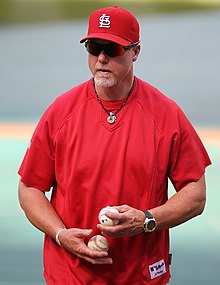
In Major League Baseball (MLB), the 50 home run club is the group of batters who have hit 50 or more home runs in a single season. Babe Ruth was the first to achieve this, doing so in 1920. By reaching the milestone, he also became the first player to hit 30 and then 40 home runs in a single season, breaking his own record of 29 from the 1919 season. Ruth subsequently became the first player to reach the 50 home run club on four occasions, repeating the achievement in 1921, 1927, and 1928. He remained the only player to accomplish this until Mark McGwire and Sammy Sosa matched his feat in 1999 and 2001, respectively. In doing so, they became the only players to have achieved 50 home runs in four consecutive seasons. Barry Bonds hit the most home runs to join the club, collecting 73 in 2001. The most recent player to hit 50 home runs in three seasons is Aaron Judge, who did so in 2024.
In total, 32 players have reached the 50 home run club in MLB history and ten have done so more than once. Of these, seventeen were right-handed batters, fourteen were left-handed, and one was a switch hitter, meaning he could bat from either side of the plate. Four of these players (including two active members of the 50 home run club) have played for only one major league team. The New York Yankees are the only franchise to have five players reach the milestone while on their roster: Ruth, Mickey Mantle, Roger Maris, Alex Rodriguez, and Aaron Judge. Ten players are also members of the 500 home run club and two of them (Willie Mays and Rodriguez) are also members of the 3,000 hit club. Ten players won the Most Valuable Player (MVP) Award in the same year as their 50 home run season. Mantle is the only player to have earned the Major League Triple Crown alongside achieving 50 home runs, leading both leagues in batting average, home runs and runs batted in (RBI). Mantle and Maris—collectively known as the M&M Boys—are the only teammates to reach the 50 home run club in the same season, hitting a combined 115 home runs in 1961 and breaking the single-season record for home runs by a pair of teammates. Albert Belle is the only player to amass 50 or more doubles in addition to attaining 50 home runs. Prince Fielder, at 23 years and 139 days, was the youngest player to reach the milestone while Bonds, at age 37, was the oldest. Pete Alonso and Aaron Judge are the only players to hit 50 home runs in their rookie seasons. (Full article...) -
Image 2

Walter Johnson holds the record with 12 different seasons that he was a strikeout leader, including 8 consecutive from 1912 through 1919. Johnson was one of the five charter members of the Baseball Hall of Fame.
In baseball, the strikeout is a statistic used to evaluate pitchers. A pitcher earns a strikeout when he puts out the batter he is facing by throwing a ball through the strike zone, "defined as that area over homeplate (sic) the upper limit of which is a horizontal line at the midpoint between the top of the shoulders and the top of the uniform pants, and the lower level is a line at the hollow beneath the kneecap", which is not put in play. Strikeouts are awarded in four situations: if the batter is put out on a third strike caught by the catcher (to "strike out swinging" or "strike out looking"); if the pitcher throws a third strike which is not caught with fewer than two outs; if the batter becomes a baserunner on an uncaught third strike; or if the batter bunts the ball into foul territory with two strikes.
Major League Baseball recognizes the player or players in each league[a] with the most strikeouts each season. Jim Devlin led the National League in its inaugural season of 1876; he threw 122 strikeouts for the Louisville Grays. The American League's first winner was Hall of Fame pitcher Cy Young, who captured the American League Triple Crown in 1901 by striking out 158 batters, along with leading the league in wins and earned run average. Walter Johnson led the American League in strikeouts twelve times during his Hall of Fame career, most among all players. He is followed by Nolan Ryan, who captured eleven titles between both leagues (nine in the American League and two in the National League). Randy Johnson won nine strikeout titles, five coming with the Arizona Diamondbacks. Three players have won seven strikeout championships: Dazzy Vance, who leads the National League; Bob Feller; and Lefty Grove. Grover Cleveland Alexander and Rube Waddell led their league six times, and five-time winners include Steve Carlton, Roger Clemens, Sam McDowell, Christy Mathewson, Amos Rusie, and Tom Seaver. (Full article...) -
Image 3

Barry Larkin is the Silver Slugger Award leader among shortstops, with nine wins.
The Silver Slugger Award is awarded annually to the best offensive player at each position in both the American League (AL) and the National League (NL), as determined by the coaches and managers of Major League Baseball (MLB). These voters consider several offensive categories in selecting the winners, including batting average, slugging percentage and on-base percentage, in addition to "coaches' and managers' general impressions of a player's overall offensive value." Managers and coaches are not permitted to vote for players on their own team. The Silver Slugger was first awarded in 1980 and is given by Hillerich & Bradsby, the manufacturer of Louisville Slugger bats. The award is a bat-shaped trophy, 3 feet (91 cm) tall, engraved with the names of each of the winners from the league and plated with sterling silver.
Among shortstops, Barry Larkin is the leader in Silver Slugger Awards, with nine wins between 1988 and 1999, including five consecutive awards (1988–1992). Larkin is fourth all-time in Silver Slugger wins among all positions, behind outfielder Barry Bonds, catcher Mike Piazza and third baseman Alex Rodriguez, who won his first seven awards at shortstop before a position change. Hall of Famer Cal Ripken Jr. won eight Silver Sluggers as a shortstop from 1983 to 1993. Derek Jeter (2006–2009; 2012) and Xander Bogaerts (2015–2016; 2019; 2021–2022) each won five Silver Sluggers as a shortstop. Francisco Lindor collected four Silver Sluggers as a shortstop, winning two each in the American and National Leagues (2017–2018; 2023–2024) Ian Desmond (2012–2014), Alan Trammell (1987–1988, 1990), Édgar Rentería (2000; 2002–2003) and Corey Seager (2016–2017; 2023) each won three Silver Slugger Awards at shortstop, with Seager winning at least one Silver Slugger across both the American and National Leagues. (Full article...) -
Image 4

David Ortiz has won the most Silver Slugger Awards as a designated hitter, with seven.
The Silver Slugger Award is awarded annually to the best offensive player at each position in both the American League (AL) and the National League (NL), as determined by the coaches and managers of Major League Baseball (MLB). These voters consider several offensive categories in selecting the winners, including batting average, slugging percentage, and on-base percentage, in addition to "coaches' and managers' general impressions of a player's overall offensive value". Managers and coaches are not permitted to vote for players on their own team. The Silver Slugger was first awarded in 1980 and is given by Hillerich & Bradsby, the manufacturer of Louisville Slugger bats. The award is a bat-shaped trophy, 3 feet (91 cm) tall, engraved with the names of each of the winners from the league and plated with sterling silver.
From 1980 to 2019, and in 2021, a Silver Slugger Award for designated hitters (DH) was only given in the American League, because use of a DH in place of the pitcher in the batting order was prohibited in the National League; a Silver Slugger Award for pitchers was given for the National League instead. In the 2020 season, the National League temporarily allowed use of the designated hitter, and no pitcher was awarded the Silver Slugger Award. An award was given instead to the best designated hitter in the National League. The first NL Silver Slugger Award for designated hitter was given to Marcell Ozuna. Beginning in 2022, the pitcher Silver Slugger Award was retired after MLB announced the full-time implementation of the universal DH rule in both leagues. The Silver Slugger Award for DH is now awarded in both leagues. (Full article...) -
Image 5
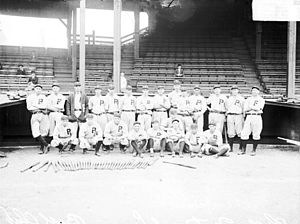
The 1915 Phillies were the first in franchise history to win the National League pennant.
This is a list of seasons completed by the Philadelphia Phillies, originally known as the Philadelphia Quakers, a professional baseball franchise based in Philadelphia, Pennsylvania.
The Philadelphia Phillies have completed 131 seasons in Major League Baseball since their inception in 1883. (Full article...) -
Image 6The New York Yankees are a professional baseball team based in New York City, New York in the borough of The Bronx. The New York Yankees are members of the American League (AL) East Division in Major League Baseball (MLB). The Yankees have won the World Series 27 times, more than any other MLB team. In baseball, the head coach of a team is called the manager. The duties of the team manager include team strategy and leadership on and off the field. Since starting to play as the Baltimore Orioles (no relationship to the current Baltimore Orioles team) in 1901, the team has employed 35 managers. The current manager is Aaron Boone, the current general manager is Brian Cashman and the current owner is Hal Steinbrenner, the son of George Steinbrenner, who first bought the Yankees in 1973.
The franchise's first manager was Hall of Famer John McGraw, who managed the team for one year and part of a second before becoming manager of the New York Giants. In 1903, the team moved from Baltimore to New York, where it was initially known as the New York Highlanders. Its first manager in New York was Clark Griffith, who managed the team from 1903 to 1908. Miller Huggins was the next manager to manage the team for more than three seasons. Huggins took over the managerial duties in 1918 and led the Yankees to six American League championships and three World Series titles until his death in 1929. Huggins won 1,067 regular season games with the Yankees, which ranks fourth all-time among Yankee managers. (Full article...) -
Image 7
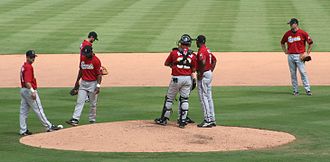
Pitching coach Stan Kyles meets with the Sounds' battery of Justin Lehr and J. C. Boscán on the mound.
The Nashville Sounds Minor League Baseball team has played in Nashville, Tennessee, since being established in 1978 as an expansion team of the Double-A Southern League. They moved up to Triple-A in 1985 as members of the American Association before joining the Pacific Coast League in 1998. With the restructuring of the minor leagues in 2021, they were placed in the Triple-A East, which became the International League in 2022. In the 2025 season, the Sounds' coaching staff is led by manager Rick Sweet and includes Eric Bunnell (general), Tim Doherty (hitting), Zack Jones (hitting), Bryan Leslie (pitching), Justin Meccage (pitching), and David Tufo (bench).
Six former Sounds players later served as coaches for the team. Wayne Garland of the 1982 starting rotation returned as pitching coach from 1987 to 1988. Don Cooper, who pitched out of the bullpen in 1980, served as pitching coach from 1994 to 1996. Reliever Steve Wilson retired from the Sounds during the 1995 season and became the team's pitching coach. Fred Dabney, a reliever on the 1993 team, returned to coach pitchers from 2012 to 2014. Éric Gagné, who made two major league rehabilitation starts in 2008, served as bullpen coach in 2019. Jim Henderson, a reliever from 2011 to 2012 and in 2014, returned to the Sounds as pitching coach in 2021. Outfielder Gene Roof (1986) and catcher Buddy Pryor (1987) were player-coaches who coached hitting while also playing on the team. Two coaches also managed the Nashville club. Pitching coach Wayne Garland filled in as interim manager for three games in 1988 after the dismissal of manager Jack Lind. Richie Hebner, who was the hitting coach from 1998 to 2000, became the team's manager for the second half of the 2000 season when Trent Jewett was hired as the Pittsburgh Pirates' third base coach. Four coaches have been selected to participate in the Triple-A All-Star Game: Stan Kyles (2006), Rich Gale (2011), Bob Skube (2014), and Rick Rodriguez (2017). (Full article...) -
Image 8

Hank Aaron, the holder of ten franchise records for the Braves
The Atlanta Braves are a Major League Baseball (MLB) franchise based in Atlanta. The Braves formed in 1871 as the Boston Red Stockings. After moving in 1953 to Milwaukee for 12 years and a World Series Championship in '57, the Braves relocated to Atlanta in 1966. Through 2010, the Braves have played 20,053 games, winning 9,945, losing 9,954, and tying 154, for a winning percentage of approximately .500. This list documents the superlative records and accomplishments of team members during their tenures in MLB.
Hank Aaron holds the most franchise records as of the end of the 2010 season, with ten, including most career hits, doubles, and the best career on-base plus slugging percentage. Aaron also held the career home runs record from April 8, 1974 until August 8, 2007. He is followed by Hugh Duffy, who holds eight records, including best single-season batting average and the best single-season slugging percentage record. (Full article...) -
Image 9

Jimmy Nelson won the PCL Pitcher of the Year Award and was selected for the Triple-A All-Star Game in 2014.
The Nashville Sounds Minor League Baseball team has played in Nashville, Tennessee, since being established in 1978 as an expansion team of the Double-A Southern League (SL). They moved up to Triple-A in 1985 as members of the American Association (AA) before joining the Pacific Coast League (PCL) in 1998. The team was placed in the Triple-A East in 2021 prior to this becoming the International League in 2022. In the history of the franchise, numerous teams, players, and personnel have won awards, been selected for All-Star teams, or led their league in various statistical areas.
Three Sounds have won league Most Valuable Player (MVP) awards: Steve Balboni, Brian Dayett, and Magglio Ordóñez. Twelve have won Pitcher of the Year awards: Bruce Berenyi, Geoff Combe, Andy McGaffigan, Jamie Werly, Stefan Wever, Chris Hammond, Scott Ruffcorn, R. A. Dickey, Johnny Hellweg, Jimmy Nelson, Robert Gasser, and Chad Patrick. Two have won Rookie of the Year awards: Jeff Abbott and Magglio Ordóñez. Five managers have won Manager of the Year awards: Stump Merrill, Rick Renick, Frank Kremblas, Steve Scarsone, and Rick Sweet. Ordóñez won the 1997 AA MVP Award as well as the Rookie of the Year Award, making him the only Nashville player to win two year-end league awards for the same season. The only other team personnel to win multiple league awards, though in separate seasons, are Renick, who won the AA Manager of the Year Award in 1993 and 1996, President Larry Schmittou, who won the SL Executive of the Year Award in 1978 and the AA Executive of the Year Award in 1987 and 1989, and radio broadcaster Bob Jamison, who was named the SL Broadcaster of the Year in 1980 and 1982. The franchise was recognized with the Minor League Baseball Organization of the Year Award in 2022. The team won the Larry MacPhail Award in 1978, 1980, and 1981. Two managers have won the Mike Coolbaugh Award: Mike Guerrero and Rick Sweet. Thirty Sounds have been selected by their Major League Baseball organization for player or pitcher of the year awards. (Full article...) -
Image 10

The 1980 Sounds set a team-best 97–46 (.678) record playing as the Double-A affiliate of the New York Yankees in the Southern League.
The Nashville Sounds Minor League Baseball team has played in Nashville, Tennessee, for 47 years since being established in 1978. As of the completion of the 2024 season, the club has played 6,566 regular-season games and compiled a win–loss record of 3,398–3,168–2 (.518). They have appeared in the postseason on 16 occasions in which they have a record of 49–44 (.527) in 93 games. Combining all 6,659 regular-season and postseason games, Nashville has an all-time record of 3,447–3,212–2 (.518).
Created as an expansion team of the Double-A Southern League (SL) in 1978, the Sounds played in this league through 1984. At the Double-A classification, Nashville was affiliated with Major League Baseball's Cincinnati Reds (1978–1979) and New York Yankees (1980–1984). The Sounds moved up to Triple-A in 1985 as members of the American Association (AA) before joining the Pacific Coast League (PCL) in 1998. They were placed in the Triple-A East (AAAE) in 2021, but this became the International League (IL) in 2022. At this level, they have been affiliates of the Detroit Tigers (1985–1986), Cincinnati Reds (1987–1992), Chicago White Sox (1993–1997), Pittsburgh Pirates (1998–2004), Milwaukee Brewers (2005–2014), Oakland Athletics (2015–2018), and Texas Rangers (2019–2020). The Sounds reaffiliated with the Milwaukee Brewers in 2021. (Full article...) -
Image 11

Babe Ruth was the first player to reach 500 home runs and set a career home run mark of 714 that stood until 1974.
In Major League Baseball (MLB), the 500 home run club is a group of batters who have hit 500 or more regular-season home runs in their careers. There are twenty-eight players who are members of the 500 home run club. Seven 500 home run club members—Hank Aaron, Willie Mays, Eddie Murray, Rafael Palmeiro, Albert Pujols, Alex Rodriguez and Miguel Cabrera—are also members of the 3,000 hit club.
In the past, membership in the 500 home run club was a guarantee of eventual entry into the Baseball Hall of Fame, although some believe the milestone has become less meaningful in recent years and many members have not been enshrined in Cooperstown. (Full article...) -
Image 12Hall of Fame inductee Hank Aaron, namesake of the award
The Hank Aaron Award is given annually to the Major League Baseball (MLB) players selected as the top hitter in each league, as voted on by baseball fans and members of the media. It was introduced in 1999 to commemorate the 25th anniversary of Hank Aaron's surpassing of Babe Ruth's career home run mark of 714 home runs. The award was the first major award to be introduced by Major League Baseball in 19 years.
For the 1999 season, a winner was selected using an objective points system. Hits, home runs, and runs batted in (RBI) were given certain point values and the winner was the player who had the highest tabulated points total. (Full article...) -
Image 13

Manny Ramirez (1991) made four all-star appearances with the Indians and led the majors in runs batted in in 1999 with 165.
The Cleveland Guardians are a Major League Baseball (MLB) franchise based in Cleveland, Ohio. They play in the American League Central division. Since the institution of MLB's Rule 4 Draft, the Guardians have selected 71 players in the first round. Officially known as the "First-Year Player Draft", the Rule 4 Draft is MLB's primary mechanism for assigning amateur baseball players from high schools, colleges, and other amateur baseball clubs to its teams. The draft order is determined based on the previous season's standings, with the team possessing the worst record receiving the first pick. In addition, teams which lost free agents in the previous off-season may be awarded compensatory or supplementary picks.
Of the 71 players picked in the first round by Cleveland, 30 have been pitchers, the most of any position; 19 of them were right-handed, while 11 were left-handed. Sixteen outfielders, eleven shortstops, four third basemen, four first basemen, four catchers, and one second basemen were also taken. The team also drafted one player, Glenn Tufts (1973), who played as an infielder. Twelve of the players came from high schools or universities in the state of California, and Texas follows with eight players. The Guardians have also drafted two players from their home state of Ohio. (Full article...) -
Image 14
The Silver Slugger Award has been awarded annually since 1980 to the best offensive player at each position in both the American League and the National League, as determined by the coaches and managers of Major League Baseball.
These voters consider several offensive statistics, including batting average, slugging percentage, and on-base percentage, as well as their "general impressions of a player's overall offensive value". They are not permitted to vote for players on their team. (Full article...) -
Image 15
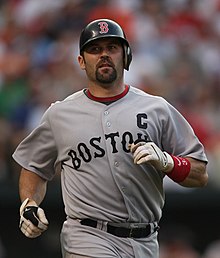
An All-American team is an honorary sports team composed of the best amateur players of a specific season for each position—who in turn are given the honorific "All-America" and typically referred to as "All-American athletes", or simply "All-Americans". Although the honorees generally do not compete as a unit, the term is used in U.S. team sports to refer to players who are selected by members of the national media. Walter Camp selected the first All-America team in the early days of American football in 1889. In 1950, the American Baseball Coaches Association (ABCA) selected its first All-American baseball team. It has since chosen All-American teams and a player of the year for each division (National Collegiate Athletic Association (NCAA) Division I, Division II, Division III, National Association of Intercollegiate Athletics, junior college, and high school). Collegiate Baseball selects All-American, Freshman All-American, and High School All-American teams. Baseball America magazine selects pre-season and post-season All-American teams and College Player of the Year honorees.
Various organizations selected All-American lists of the best players for the 1994 NCAA Division I college baseball season. The ABCA, the magazine Baseball America, and Collegiate Baseball were the NCAA-sanctioned selectors. This list only includes players selected to the post-season All-American first team for each selector. However, many All-American selections choose second, third, etc. teams from the remaining eligible candidates. (Full article...)
More did you know
- ... that despite its author keeping detailed journals of his experiences, the baseball memoir Odd Man Out was criticized by many people named in the book as being factually inaccurate?
- ... that the longest extra inning game in professional baseball history was an International League game that lasted 33 innings?
- ... that two members of the $100,000 infield have been inducted into the Baseball Hall of Fame?
- ... that three of the four batters faced by Mike Palagyi in his one Major League game were later inducted into the Baseball Hall of Fame?
- ... that Boston Red Sox third baseman Will Middlebrooks is engaged to a former Dallas Cowboys cheerleader whom he has known since childhood?
Sports portals
Selected picture

| Credit: Keith Allison |
Chien-Ming Wang (Chinese: 王建民; pinyin: Wáng Jiànmín; Wade–Giles: Wang Chien-min; born March 31, 1980) is a Taiwanese starting pitcher for the Washington Nationals in Major League Baseball. He was initially signed as an amateur free agent by the New York Yankees prior to the 2000 season. He came to be known as the Yankees ace pitcher over the 2006 and 2007 seasons.
Associated Wikimedia
The following Wikimedia Foundation sister projects provide more on this subject:
-
Commons
Free media repository -
Wikibooks
Free textbooks and manuals -
Wikidata
Free knowledge base -
Wikinews
Free-content news -
Wikiquote
Collection of quotations -
Wikisource
Free-content library -
Wikiversity
Free learning tools -
Wiktionary
Dictionary and thesaurus
More portals
- Portals with triaged subpages from June 2018
- All portals with triaged subpages
- Portals with no named maintainer
- Automated article-slideshow portals with 51–100 articles in article list
- Automated article-slideshow portals with 501–1000 articles in article list
- Random portal component with 41–50 available subpages
- Automated article-slideshow portals with 201–500 articles in article list
- Random portal component with 11–15 available subpages
- Random portal component with 21–25 available image subpages

